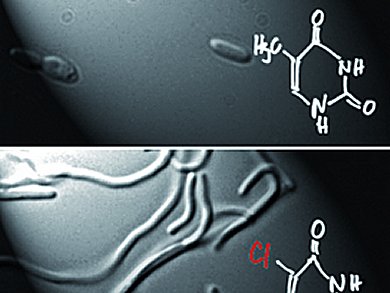Chemical Evolution Generates Bacterial Strain With Artificial Nucleotide in its Genome
Evolution is based on heredity, changes to the genetic material (mutation), and the natural selection of those organisms that are best suited to the given environmental conditions. An international team led by Rupert Mutzel at the Freie Universität of Berlin has now successfully emulated one particular evolutionary process in the laboratory. As the researchers report in the journal Angewandte Chemie, they were able to generate a bacterial strain whose genetic material contains an artificial building block in place of a natural one. Their success results from a special automated cultivation technique.
DNA, the carrier of the genetic information of all cells, is based on a code consisting of four “letters”, the bases adenine, cytosine, guanine, and thymine. Thanks to their new artificial evolution process, the scientists have now been able to grow bacteria in which the thymine of DNA has been replaced with an analogue, the base 5-chlorouracil. This synthetic component is poisonous to other organisms.
The researchers started with a genetically modified strain of the bacterium Escherichia coli that is no longer capable of producing thymine. These microorganisms were cultivated over many generations in the presence of increasing amounts of chlorouracil in a specially built apparatus. Whenever the size of the population sank below a certain level, the bacteria were given a brief dose of a chlorouracil-free, thymine-containing medium to give them a chance to recover. The concentration of chlorouracil was automatically increased whenever genetic variants of the bacteria that better tolerated this substance were produced. In this way, the cells were always exposed to a quantity of chlorouracil that was just barely tolerable. After about 1000 generations, the microorganisms had adapted to the altered environmental conditions, that is, the presence of chlorouracil instead of thymine. They were able to build up their DNA with chlorouracil in place of thymine. Analysis of the genome showed that the process of adaptation resulted in many changes to the genetic material of the bacteria.
“Our results demonstrate the success of our evolutionary cultivation strategy,” says Mutzel. “In this way it should be possible to develop microorganisms that can convert chemical intermediates to pharmaceuticals or break down environmental pollutants.” Microorganisms that have DNA with synthetic building blocks may also be useful in hindering the spread of purposely or accidentally released modified cells in the environment. Such microorganisms would also be incapable of exchanging genes with their natural relatives.
- Rupert Mutzel, Freie Universität Berlin, Germany
- Chemical Evolution of a Bacterium’s Genome,
Angew. Chem. Int. Ed. 2011, 50 (31), 7109–7114.
DOI: 10.1002/anie.201100535




